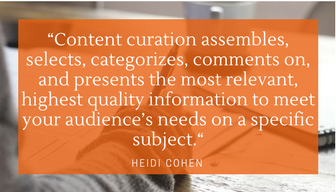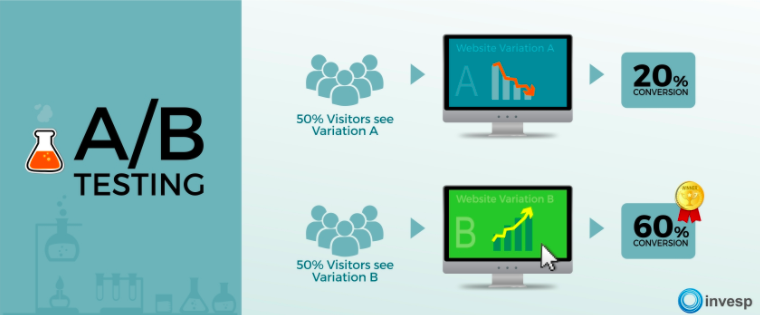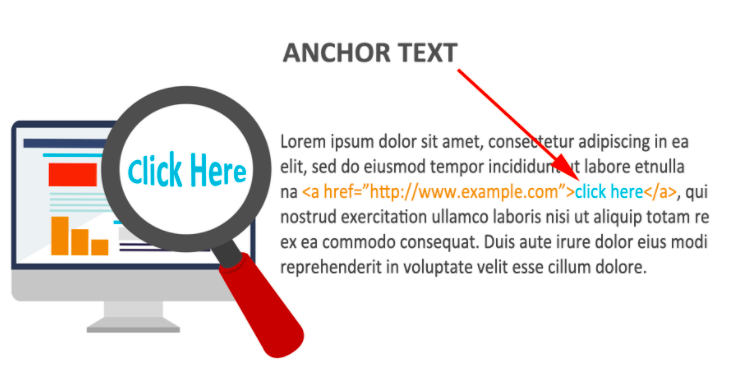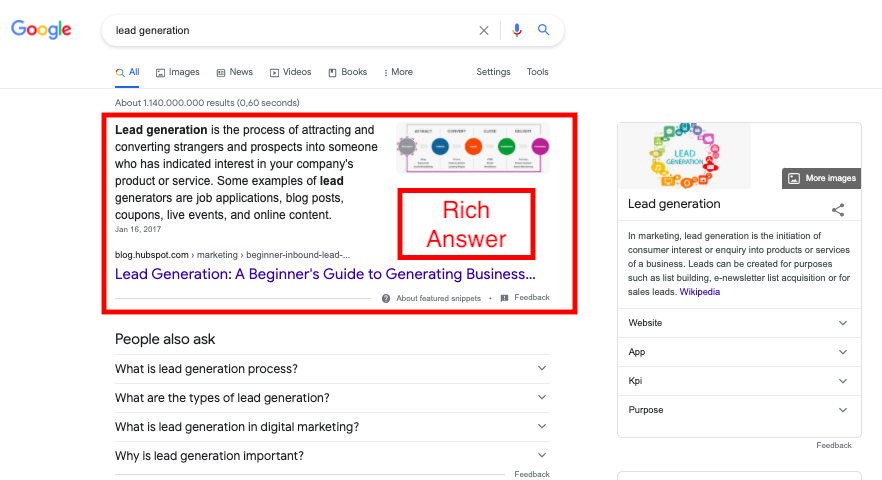When I started out as a content marketer and later as a blogger, I had to learn many terms that I had never heard of before. Sometimes I felt a little stupid when the experts around me talked in all those buzzwords that sounded like Chinese to me. To help you find your way around the jungle of blogging terms and marketing buzzwords, here is a list of terms a new blogger will stumble across and a short explanation for each of them.
#1 Above the fold
This is the part of any webpage that you can see before you start to scroll. The origin of this term comes from newspapers that were usually folded in half. Above the fold meant the top half of the newspaper that you could see on top when it was folded.
#2 A/B Testing or Split Testing
This means testing different versions of websites or content and measuring which performs better. There are endless things you can A/B test: Landing Pages, Email Subject Lines, Call-To-Actions. Usually, two versions are created and shown to part of a larger audience and the outcome gets measured. Statistical analysis is used to determine which of the variants performs better and gets better results from website visitors.
Before you read on - we have various resources that show you exactly how to use social networks to gain massive traffic and leads. For instance, check out the following:
FREE Step-by-Step Twitter Marketing GuideFREE Pinterest Marketing Ebook
Image Source: Invesp
#3 Adsense, Google Adsense
Adsense or Google Adsense is the advertising system provided by Google. Adsense can be used to fill your advertising space on your blog with ads and make money from it without having to search for advertising customers.
#4 Affiliate Marketing
Affiliate marketers market the product of another blogger or business owner to an audience and earn a commission for each product that is bought this way. Affiliate marketing is a way to earn money with your blog when you do not have any own products to sell.
Affiliate marketing describes the performance-based marketing process where a business (affiliate) markets the products of another business and earns a commission for each product that he sells for them.
#5 Alexa Rank
Data and optimization – Alexa rank measures the popularity of a website. Alexa ranks millions of websites. An Alexa rank of 1 is the best any website can reach – the larger the Alexa rank the less popular a website is. Alexa rank can be viewed for various regions. You can check the Alexa rank for any website on Alexa.
Alexa Rank 1 is Google.com.
#6 Alt Tag, Alternative Tag, Alt text
Also known as alt attributes, alt descriptions. Alt attributes describe the alternative description of images for search engines. It functions as the alternative to the image if the image cannot be used or displayed for any reason. Search engines use the Alt Tags to understand what an image is about – and that means if you don’t fill out the Alt Tags, search engines will have no clue what your image is about.
#7 Analytics, Google Analytics, Website analytics
Analytics refers to all computational analysis of data and statistics. In blogging and online marketing analytics often is used short for Google analytics but other tools also provide data and statistics for bloggers and marketers. Generally, analytics refers to all statistical data around your website and marketing efforts: Traffic, time on site, followers, engagements, …
Google Analytics is a website analytics service or tool provided by Google that gives you the numbers about your website that can answer (almost) all your questions about your audience and website performance. There are other website analytics tools as well but Google Analytics is by far the most commonly used – and it comes for free which makes it absolutely affordable for all new bloggers on a budget.
Hey, before you read on - we have in various FREE in-depth guides on similar topics that you can download. For this post, check out:
FREE workbook: CREATE AWESOME BLOG POSTSFREE Beginner's Guide: START A BLOG
#8 Anchor Text
Usually, a link on a blog is not displayed as the URL. Instead, the clickable URL is hidden behind the text – often within a blog post. Anchor text is the clickable text/words used to link from one website to another.
Image Source: Serpstat
#9 Audio Blog:
A blog that mainly uses vocal recordings as content. A typical content format for audio blogs is podcasts.
#10 Autocasting
Autocasting describes the process of automatically turning a blog post into spoken words that can be downloaded or listened to like a podcast.
#11 Automate, Automation
Describes the usage of tools to perform certain tasks that otherwise would take up a lot of human manpower. In blogging and marketing, typical automated tasks are email automation and social media marketing automation as scheduling of posts.
Marketing automation means that tools perform the marketing tasks for more efficiency and the possibility to scale your marketing.
#12 Avatar
A small image representing a blogger, marketer, or social media user online. Using the same image as an avatar in many outlets will increase recognition.
In social media, an avatar describes a profile picture or a graphical representation of a user.
#13 Backlink
A backlink for any website is a link from another website to this website. Backlinks connect one website with another via a link. Backlinks are also referred to as incoming links or inbound links.
The number and quality of backlinks are an important ranking factor in the Google search algorithm that determines in which position shows up in the search results for a search term.
#14 Black Hat (SEO)
SEO – Black hat SEO tactics are shady tactics that may help you to rank higher in Google search results but violate Google’s rules or best practices. Black hat tactics come at the risk of getting downranked or even shadowbanned by Google.
There is not ONE LIST of black hat SEO methods. Basically, the definition of black hat SEO methods are methods that Google does not like. Any tactic to improve your search rankings can turn into a black hat method from Google’s point of view if Google decides so and the Google algorithm changes.
#15 Blog Commenting
Blog commenting is the process of publishing comments on other people’s blogs. Blog comments should add value to a blog post. Blog commenting can also be used as a link building tactic.
#16 Blogger Outreach
Blogger Outreach is the process of reaching out to other bloggers and building relationships. Blogger outreach usually has a motive and a goal like guest blogging opportunities, link building, or getting a blogger to review a product or tool.
#17 Blog Header
The topmost section of your blog. The blog header usually includes the logo of your blog, the name of the blog, and some links to help readers navigate the blog’s website.
#18 Blogosphere
Networking – the blogosphere refers to all blogs and the connections between the blogs and the bloggers. You can consider the blogosphere as a community of all blogs. Connecting and building relationships with other bloggers means a new blogger is becoming part of the blogosphere.
#19 Blogroll
A list of blogs that a blogger recommends to his/her audience. Blogrolls are often displayed in the sidebar of a blog.
#20 Blog Sidebar
One column of a blog, usually on one side. The blog sidebar is often used to promote stuff like the newsletter signup, products that the blog offers, or related content.
#21 Bots
An Internet bot is a software application that runs automated tasks – usually simple or repetitive tasks. Examples for bit tasks are Twitter accounts that automatically retweet all tweets that mention a certain hashtag. A newer bot development is Chatbots that provide customers or users with information based on their questions.
#22 Bounce Rate
The bounce rate describes the percentage of website visitors that only visit one page on your website. Instead of clicking on an (Internal) link on the website and visiting another page on the website, these visitors leave the site after viewing only one page – they bounce. A bounce is a visitor that leaves after visiting one page only.
Image Source: Google
#23 Call-to-Action
A call-to-action is a piece of a website like a button, a keyword, or a phrase that is intended at making a website visitor perform an action. A call-to-action is often an instruction or directive. Examples for a call-to-action are “Check this out” or “Click here”, “Buy Now” or “Signup Here.”
Image Source: ConvertKit
#24 Captcha
CAPTCHA is an acronym for “Completely Automated Public Turing test to tell Computers and Humans Apart.” Captchas are used to determine if a website visitor is human – or a bot. Often Captchas ask you to type a sequence of numbers and letters that is displayed in a form that cannot be read by a computer or you are asked questions about images you see.
#25 Clickbait
Clickbait refers to a headline or a hyperlink text that has the sole purpose of making people click on the link. Clickbait is not necessarily bad – every great headline can be viewed as clickbait when used to share a piece of content on social media. But there are forms of clickbait that use false pretenses and even lies to lure people to click on a link.
#26 Click Through Rate/Click Thru Rate (CTR)
Click-Through Rate means the ratio between people that have seen an ad or link to the number of people that actually clicked on the ad or link. Basically the ratio between the people that could have clicked to people that clicked. Click Through Rate is used to compare the success of ads or other marketing means like email.
Commenting – see Blog commenting
#27 Comment Spam
Comment spam describes all comments on blogs or websites that do not add value to the post or topic but instead try to advertise some other website or product. A typical spam comment is “Great post. Visit my website (LINK).”
#28 CMS – Content Management System
A Content Management System is computer software that is used to manage the creation, editing of digital content. Some of the most commonly used CMS are WordPress, Drupal, Joomla, and others.
#29 Content Curation
Content curation describes using existing content (possibly created by someone else) and re-using it. Never get it mixed up with stealing content – don’t do that ever. Content curation is the process of researching content on a given topic, reviewing it, assembling, and presenting this content in a useful way to your audience.

#30 Content Marketing
A type of marketing that uses informative and useful content to grab the attention of an audience, build trust and eventually convert customers through content instead of overly promotional messages.
#31 Content Syndication
Content syndication means re-publishing content on another website AFTER it has already been published.
#32 Content Upgrade
A content upgrade is a piece of additional content that you offer to your blog readers in exchange for their email address. Content Upgrades can be used as lead magnets and help to increase the number of new subscribers to your email list.
#33 Conversion Rate
The conversion rate is the percentage of people that take the desired action. For instance, the percentage of people that buy a product from all people who got the offer.
#34 Cost Per Click, CPC
Cost Per Click (CPC) is a term from the advertising space that describes the average cost that you have to pay to make people click on a link you provide. Often used as a synonym for Pay Per Click (PPC) which means a model of advertising where you have to pay a fee each time someone clicks on the ad.
#35 Cost Per Mille, CPM
Cost per Mille measures the costs of advertisements. You do not pay per click. Instead, you pay a price for 1000 views of your ad. How many people click on it is irrelevant for the price.
#36 Creative Commons License
A creative commons license is a public copyright license that makes otherwise copyrighted content like images, audio, or even video free for distribution and use. Please check the exact terms for the creative commons license before you use the license or content that is licensed with it!
#37 CSS, cascading style sheets
A stylesheet language that basically describes how a website that is programmed in HTML is shown on the web.
#38 Curated Content
Curated content means content that you have not created yourself but present to your audience – with proper reference or link to the owner of the content. You can use curated content on your blog or social media to add value for your audience.
#39 Dashboard
The dashboard is the home or base area of your CMS (for instance WordPress) where you can add and edit content, install plugins, and more.
#40 Deep Linking
Deep links mean links that go to specific blog posts or pages on a website in contrast to linking to the homepage.
#41 Direct Traffic
People that come to your blog or website by typing the link into their browser instead of following a link on social media or another website fall in the category of direct traffic.
#42 DoFollow link
DoFollow links pass on Google trust and ranking signals to the linked website. Dofollow is in contrast to NoFollow links that Do NOT pass on any link juice.
#43 Domain Authority:
Domain Authority is a search engine ranking score. It describes the “strength” of a domain.
#44 Domain Name:
The Domain Name is the identification string of a website. It is the foundation of your website.
#45 eBook
An eBook is a digital book that is not delivered as printed paper but as a file – ost of the time the file format of an ebook is .pdf.
#46 Editorial Calendar:
An editorial calendar is a publishing schedule used by bloggers, content marketers, and editorial teams to control processes and workflows around content creation and publication.
Image Source: Hubspot
#47 Email Marketing
Email marketing is a digital marketing strategy that evolves around sending emails to a lot of people. Email marketing is one of the most effective marketing channels for making sales.
#48 Engagement
With engagement all kinds of interaction between two or more people on the net. For your blog engagement with your audience means comments and shares of your blog content. Social media engagement means likes, comments, and shares of social media posts.
#49 Evergreen content
Evergreen content is content that stays relevant for a long time – in contrast to news or even content.
#50 External Link
External links are links from a website that point to pages on another website. This is in contrast to Internal Links.
#51 Favicon
A favicon is a mini icon or tab icon. You can see favicons on the tabs of your browser.
#52 Focus Keyword
The focus keyword is the main keyword for which a piece of content is optimized. The focus keyword is the keyword for which you want your piece of content to rank in search engines.
#53 Followers
Followers are part of your audience. They can be subscribers to your blog or people who listen to you (follow your updates) on social media.
#54 Follow-Unfollow
The follow-unfollow process is a trick to gain more followers on social media. You follow some people from your target audience and since many people on social media tend to follow back new followers, you will gain followers. In order to not overcrowd your social media accounts, you later unfollow all people that did not follow you back.
To make this routine a success, you need to be careful not to break the rules of the social networks and make sure that you target the best followers.
#55 Font
A font is the size, weight, and style of a typeface.
#56 Freebie
A freebie is a (small) product that you offer your web audience in exchange for their email address. The term Freebie is used similarly to lead magnet.
#57 FTP File Transfer Protocol
FTP is a network protocol that is used to transfer files between client and server in a computer network.
#58 Gravatar – Globally Recognized Avatars
A gravatar is an image or photo that follows you around the web. Your gravatar will appear in many places on the web besides your name and make it more recognizable.
#59 Google Ranking Factors
Google ranking factors are factors that Google uses to determine in which position it is showing certain search results. Knowing the ranking factors that Google uses allows you to improve them. You can find the most important Google ranking factors here.
#60 Google Search
Google is the most used search engine on the web. Google search is an important traffic source for blogs and websites.
#61 Guest post
A guest post is a blog post that someone writes and then not publishes on their own blog but on a blog where they are a guest.
#62 H1, H2, H3 Tags, Heading Tags
heading Tags describe headlines on a website. H1 should only be used once per page. H1 usually is the title of a website and should include the focus keyword that you want your post to rank for. H2 are subheadlines. H3, 44 subheads are used to add further structure to a post.
#63 Hashtag
A hashtag is a special type of keyword that follows a hash sign #. Social networks use hashtags to group posts mentioning one hashtag. A hashtag serves as an identification that something belongs to a topic that is described with the hashtag.
Some social networks put more emphasis on hashtags than others. You can learn more about hashtags here.
Header – see Blog Header
#64 Hits
Hits is a number that measures the number of visitors (hits) to a website.
#65 Host, Hosting service, Hosting provider
A hosting provider provides space on a webserver to store data and files of a website to make the website accessible via the World Wide Web (www.) this is called hosting a website. There are various hosting services. Choosing the best hosting provider is crucial for a website owner.
When we started out with this blog, we did not make the best decision. Read our hosting story here!
#66 HTML, Hypertext Markup Language
HTML is the (programming) language that is used to create web pages.
#67 Hyperlink
Hyperlinks are also called links. Links are clickable content snippets that take users from one website to another website.
#68 Hyperlocal
Content that is only relevant for a small group of people or community.
#69 Index, Indexed
In the blogging world, the index usually refers to the search index. Being indexed means that a search engine noticed your website and ranked it. You can check if your website was indexed by searching for it. If it appears in the search results, it was indexed. New websites can take a while until search engines recognize them.
#70 Infographic
An infographic is a type of image that displays complex information in the consumable form of an image. Infographics often use a narrow but high format and are read top-down.
Infographics are still a popular marketing tool.
#71 Influencer, Influencer marketing
An influencer is someone who can reach a large audience. In social media, this often refers to people with a large number of engaged followers. Influencers can use their online influence to make money by promoting products or services and earning money for the promotion.
#72 Internal link
A link from one web page on one domain to another web page on the same domain. Internal links can sometimes also be used to link from one spot or snippet on a website to another snippet – this can be used to “jump” within long webpages.
Internal links have SEO power and can be used to help the ranking of specific pages on one domain.
#73 Keyword(s), Keyphrase
Keywords and keyphrases describe the topics that your audience is interested in AND using the words that your audience uses. Picking keywords and phrases that people search in search engines can help you rank your content in search results pages.
#74 Keyword research
The process of finding the best keywords to describe a topic that your audience is interested in AND keywords that you have a chance to rank for in search engines is described as keyword research.
Doing great keyword research is crucial to online marketing success and search engine optimization.
#75 Keyword Stuffing
Using the best keywords to describe a topic is good marketing. Using too many keywords to over-emphasize what your content is about and trying to trick search engines into ranking your content higher is called keyword stuffing. Keyword stuffing is bad!
#76 Lead Magnet
A lead magnet is a piece of content – often an ebook, pdf – that is offered as an incentive for people from your audience to give you their email address. Lead magnets can also be referred to as content upgrades or freebies.
Link – See Backlink
#77 Link Bait
Content that is created with the main goal of gaining backlinks. Some examples of linkbait content are Infographics, top lists of blogs or people, interviews, expert roundups, and even statistics.
You can find more about link bait and some examples here.
#78 Link Building
The process of actively building links to a website is called link building. Link building tactics include link bait, broken link strategy, link exchange, and blog commenting.
#79 Link Exchange
If bloggers link to each other’s blog this is called link exchange. The process is discouraged by Google as it is prone to shady link tactics. This can be viewed as a black hat tactic.
#80 List Building
The process of growing an email list with email addresses from your target audience is called list building. List building is an important part of email marketing.
#81 Listicle, List Post
A listicle is a term for list posts like “600 SEO tips for more traffic from Google search” or “the 20 best blogs you need to know in the automotive industry.”
List posts are a popular type of blog post for social media and Google search.
#82 Longform Content
Content and blog posts that contain more than 1000 words. For SEO reasons content for online marketing purposes should have a minimum of 300 words. Research shows that longer posts with a minimum of 2000 words often perform better from a marketing standpoint.
#83 Longtail, Longtail Keywords
Longtail keywords are key phrases that contain a keyword and some keyword specifiers that make the longtail keyword more specific with fewer searches for this term – but also less competitive than main keywords. It is often easier to rank for longtail keywords.
Here is how to find and use longtail keywords in your marketing.
#84 Meta Description
A meta description is part of the HTML description of a website. The meta description should provide a summary of the website or information that a reader can find on this website. The meta description is by Google and other search engines to provide a short teaser of the website’s content in the search result.
If you fail to provide a meta description for your website search engines will pull random information from the website – often the first paragraph of the text on the site.
#85 Meta Keywords
An element of a website that has been used to give a quick hint of the content of the website. Search engines used these keywords to identify the topic of a website. Since the Meta keywords have often been misused and were no longer a good indicator of the content of a website these meta keywords are no longer relevant for search engines.
#86 Meta Tags
The combination of the meta description, meta title, and keywords are referred to as meta tags. Meta tags are part of a website’s description but not visible on the website.
#87 Meta Title
The meta title is also called a title tag. This post title also shows as the bold title for your content in search engine results.
#88 Microblog
Microblogs are blogs that post content of fewer than 300 words. Microblogs often post more often than blogs that publish long-form content.
Microblogs often add other types of content like gifs, videos, links, or infographics to their short-form content.
#89 Mobile Optimized
A website that is written or adjusted to give viewers on a mobile device a good user experience. Today, you need to be careful to choose a mobile-optimized or responsive design to cater to people visiting your website from mobile.
CMS like WordPress offers multiple themes that already are mobile optimized.
#90 Monetization
All methods you can use to make money from your website or blog. The most common blog monetization methods include affiliate marketing, advertising, and selling of digital products.
#91 Multiblogger
Multiblogger describes a blogger who runs multiple blogs at the same time.
#92 Newsletter
A newsletter is an email that is sent to a subscriber list.
#93 Niche
A niche is a segment of a market that is interested in similar topics and faces similar problems.
#94 NoFollow
Links with a Nofollow attribute do not pass SEO juice from one page to another.
#95 Off-Page SEO
Off-page SEO means all SEO activities that do not take place on your website. This includes Link-building tactics, guest posting. Off-page SEO is often viewed as similar to link building but it is more than that. Off-page SEO includes your reputation and branding process, your social media activity, and more.
#96 On-Page SEO
All SEO optimization that you can do on your website is part of on-page SEO. Page load times and your website structure is as much part of on-page SEO as the optimization of your posts and layout.
#97 Opt-In
Opting into an email list means that the new subscriber actively decides to join the list.
#98 Organic Traffic
Organic traffic is opposed to paid traffic. Organic traffic summarizes all website visitors that came to your website through unpaid sources like links, from social media, your email newsletter, or directly to your website.
#99 Page Rank
Page rank is a way that the google search algorithm used to rank the importance of all websites. Page rank was based on the number and quality of backlinks to a website.
#100 Pageviews
The number of page views is the number of people that view a web page in a specific timeframe.
#101 Pay Per Click
Pay per click is a term from advertising. Instead of paying an ad for the number of times, it is shown to someone from your target audience, you only pay if someone clicks on the ad.
#102 Permalink
A permalink is the URL of a blog post or web page. This URL should not be changed.
#103 Pingback
a pingback is a notification that is created automatically when there is a new link to a website from a third-party website.
#104 Plugin
A plugin is a predefined software component that you can add to your software to add a specific feature to the program. There are plugins for many programs. Famous are WordPress plugins but there are also browser plugins and others.
#105 Post, Blog post
In blogging, post or blog post is used synonymously to article or blog article.
#106 Re-Blog
Re-Blogging means reposting an already published post. Reblogging should always include some updates and additions that make the information fresh.
#107 Reciprocal link
As the term suggests this is are two links between two blogs, one in each direction. This can be viewed as a shady link practice by Google and may lead to penalties.
#108 Redirect
A redirect is used if a URL is changed or if an alternative URL is used. Then a redirect from one URL to the other makes sure that no URL leads to an empty or non-existing page.
#109 Referral traffic
Referral traffic is all traffic that comes to a website via a link from another website.
#110 Rich Answers
Rich answers are part of the Google search results page. A rich answer is the snippet of information that is displayed on top of the list of search results.
#111 ROI = Return on Invest
The ROI is a number that estimates the monetary value of any venture. The ROI is the value that tells you how much money you earn for the money that you invest. The larger the ROI the more money you earn for each $ you invest.
#112 RSS, RSS Feed
RSS is short for Really Simple Syndication. RSS allows you to subscribe to a blog or feed. Subscribing to a blog via RSS allows people to get information about new posts without checking the website over and over.
#113 Self-hosted Blog
Self-hosting means that the blog owner caters to the hosting himself. This in opposition to blogs on hosted blogging platforms like WordPress.com which limits your option for money-making.
If you need advice on how to choose a hosting service, read this first.
#114 SEO
SEO= Search Engine Optimization is the process of increasing the traffic to your content from search engines by improving the ranking of content in the search results.
#115 SERPs
SERP is short for Search Engine Results Page. SERP is a term from the SEO world and is usually used in connection how your blog ranks in the Google search results.
Sidebar – see Blog Sidebar
#116 Sitemap
A sitemap is a directory or list of all pages on a website. There are different types of site maps.
- site maps used by designers during the planning process of a website
- site maps visible to human beings that display the main structure of a website and allows to find the right content fast
- site maps for web crawlers of search engines to make sure that they find all pages on a website
The sitemaps protocol is used by webmasters and search engines to decide which pages to crawl.
#117 Slug
The part of a website URL that starts after the .com or .net
#118 Social Proof
In a world where the number of shares or likes is a sign of quality, social proof is the proof of quality through social media shares.
#119 Social search
Social search means searches that are made on social media sites rather than in search engines like Google. For instance, Youtube is a social platform but it is also the second-largest search engine.
#120 Spam
Spam is digital junk. Most of the time spam is referring to unsolicited emails that contain no useful information that is sent out via bots or automated messaging systems in bulk.
There is not only spam in email marketing. There is also spam content which is content with no real value to their readers that has another purpose like attracting search traffic or content that promotes fishy products.
Split Testing – See AB testing
#121 Sponsored post
A sponsored post is a blog post that someone paid the blogger for publishing. Sponsored posts are a special form of advertising hidden behind blog content.
#122 Subscriber, Subscribe
A subscriber is a person who has agreed to get newsletter emails from someone. People can subscribe to email lists and will then receive emails from the owner of this email list.
#123 Tags, Tag
Tags are words or phrases that are used to sort larger numbers of blog posts into topic areas. A tag is something similar to a category.
#124 Tagline
A tagline is a slogan or catchphrase. It can be used in advertising – or to describe the purpose of a blog.
#125 Template
A template is a model or pattern that you can use and adjust according to your needs. Using templates as a starting point often saves you a ton of time.
#126 (WordPress) Theme
A theme is a combination of graphics, style sheets and code that provides design for a (WordPress) website. The theme takes content and files and presents them in a visually appealing way. The theme provides style elements that you can modify to your needs.
#127 Trackback
A trackback is a notification that one blog sends to another blog or linking website to inform about updates.
#128 Traffic, Web Traffic
All visitors to a website or page within a specified time frame is summarized as (web) traffic.
#129 (Internet) Troll
A troll in the digital world is someone who starts a conversation with the purpose of upsetting people. This can start as negative comments. No matter how you try to argue with trolls, you can never win as they will never be convinces since their purpose was to start a negative conversation.
#130 Unique visitor
A unique visitor is a KPI of online marketing. A unique visitor is exactly one visitor to a website that may visit multiple pages of the site.
Unique visitors are often confused with page impressions or visitors.
#131 URL
The URL (Uniform Resource Locator) is the web address of a piece of information that can be found online. The URL specifies the location of a piece of content on the Internet.
#132 Vlog
A vlog is a video blog. The content of a vlog is mainly video instead of written content.
#133 Virtual Assistance
A virtual assistant is someone who takes over administrative tasks for bloggers. Virtual assistance usually work remotely.
#134 Webinar
A webinar is an online class. Often a webinar is a live seminar or workshop. Webinars are powerful tools when it comes to online selling.
#135 White Hat SEO
All SEO tasks that are accepted by Google. There is no official list of White hat SEO practices. A practice that used to be white hat can be declared black hat by Google any time.
#136 Yoast
Yoast is a famous WordPress plugin that helps you with your SEO for every blog post.
Final Words on Blogging Terms
When I started out as an online entrepreneur and blogger many of the above blogging terms were new to me and I had to learn about them along the way. I hope the above list will help some new bloggers to understand some more about blogging faster.
If you have some more blogging terms I should add to the list, let me know!
Do you want to create better blog posts? Do you want to learn about some types of blog posts you did not know? Do you need help to structure your posts in the best way?
Our Blog Post Templates help you with all that. Get 6 blog post templates for free. Download our blog post templates here!










